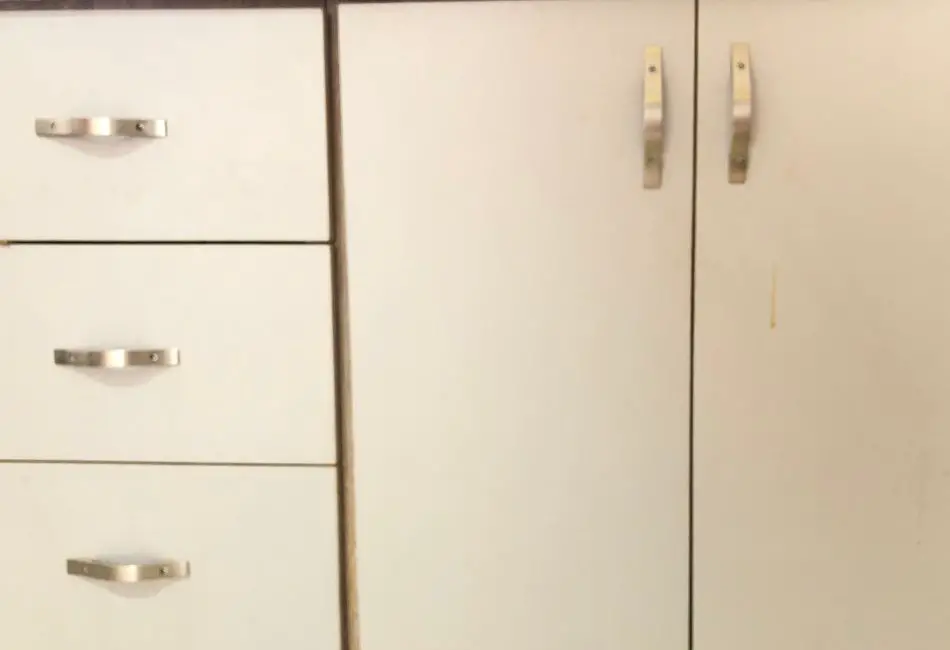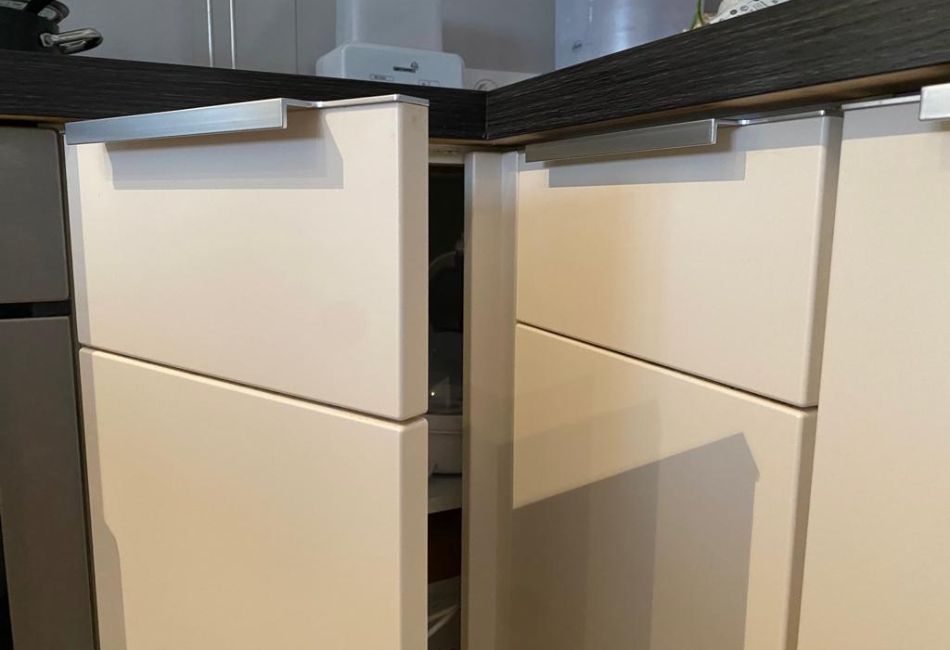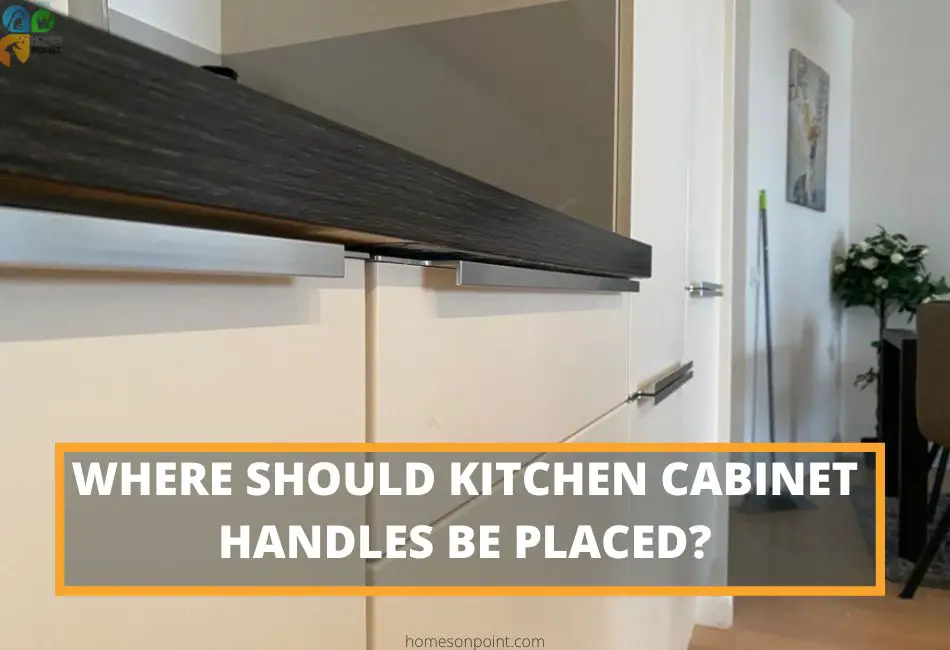The littlest details such as the handles of your kitchen cabinets and how they are placed can be a game-changer for how your entire kitchen looks and if you will enjoy using it. Generally, your budget and preference lead you to select your kitchen cabinet handles. However, no matter how stylish these handles are, they can offset the look of the kitchen and the functionality of the cabinets if placed wrongly.
Kitchen cabinet handles can be placed horizontally or vertically at the lower or upper corner of the cabinet. Moreover, they can be centered on the inset panel/recessed drawer panel, the top rail cabinet, the seam of the cabinet door, or placed on each side of the cabinet at a certain distance from each other.
The placement of kitchen cabinet handles can be based on your own decision but you can save yourself a lot of trouble by taking professional advice and placing them correctly so you enjoy using your cabinets.
Thus, the type of kitchen cabinet handles and the size of the cabinet dictate the most functional positioning of your handles.
Different Types of Kitchen Cabinet Handles
Everyone considers some factors before choosing their cabinets and their handles. The type of kitchen cabinet handle helps one know its correct placement. There is a plethora of kitchen cabinet handles on the market, but they can be grouped under 3 umbrellas.
1. Knobs
Knobs are a type of kitchen cabinet handles that are great for doors and drawers alike. They come in different shapes and sizes, making them easier to use regardless of the style of your kitchen and its cabinets.
Knobs are usually smaller and cost lesser than other cabinet handles. They are also usually easier to fix as you are required to fix it on just a screw, requiring you to drill one hole per knob.
Types of knobs include mushroom, round, oval, square, rectangular, conical, cylindrical, and bar knobs. You can also find other unique shapes like animals and flowers. Moreover, these knobs come in wood, ceramic, and/or crystal.
2. Pulls
Pull kitchen cabinet handles are relatively easier to use though it may require a lot to have them installed. Precision is required to drill the holes and has the pulls fixed so the result is not slanted or improperly aligned with the cabinet door or drawer.
Types of pulls include cup or bin pull, bar pull, drop bail or bow pull, and finger pull and they are easy to use. Pulls also present a clean minimal look so are great for most kitchen styles.
3. Edge Handles
Edge handles are also known as edge profile handles. They give a minimalist feel but are more expensive than pulls and knobs mainly because they offer a classier look to the kitchen.
Edge handles add a contemporary touch to your kitchen as they make it seem like your cabinets do not have handles. Edge handles do not require any holes to be drilled as they are fitted behind the cabinet door or drawer.
Since edge handles give a modern look, they do not work in traditional kitchens because they will look out of place.
The types include j, c, g, and l profile handles. The edge profiles are named after the shape of the area that is supposed to be gripped to open the cabinet door or drawer.
Where To Place the Different Types of Kitchen Cabinet Handles
You might think that once you select which type of cabinet handles you like and can afford them, that is it. However, you need to know the right positioning of these handles so that using the cabinets won’t be tiring and cumbersome.
Honestly, there is no correct way to place any cabinet handles but there are some rules of thumb to follow for the utmost functionality of the kitchen.
The different types of cabinet handles have their unique ways of placement on cabinet doors and drawers.
1. Knobs

The positions will vary depending on which kitchen cabinet the knob handles are being placed on. For cabinet doors, knobs placement should be opposite the hinges. However, the distinction is made also depending on if the cabinets are lower or upper cabinets, are drawers or the standard sizes or not.
For upper cabinets, knobs should be placed on the lower corner of the cabinet door. Typically, the best functional positioning is between 2.5 to 3 inches from the edges of the cabinet doors.
For lower cabinets, knobs can be placed either on the upper corner of the cabinet door or the middle of the rail of the cabinet door.
For drawers, knob handles should be placed in the middle of the drawer front. Moreover, depending on the size of the drawer, you may need two knobs per drawer, so it becomes easier to use it.
The standard drawer size is 24 inches in length, so if you have one that measures more than that, it is advisable to fix two knobs. In this case, divide the drawer length into three and install the two knobs on the one-third and two-thirds marks.
2. Pulls

Pulls can be placed either horizontally or vertically on kitchen cabinet doors or drawers. There is more flexibility in the placement of pulls as compared to knobs.
For cabinet doors, pulls can be placed vertically about 2 to 3 inches from the edge of the door in the center, especially if it is a long cabinet door.
Also, pulls can be placed vertically at the upper corner of the door of the lower cabinets and the lower corner of the door of the upper cabinets. In both cases, the pull should be about 2 to 3 inches away from the edge of the door.
On the other hand, for drawers, pulls should be positioned horizontally in the middle of the drawer front or about 1 to 2 inches from the top of the drawer front depending on the depth of the drawer. For a better picture, if you divide the drawer front into three equal sections, the pull should be placed in the middle section.
If the drawer is longer than normal i.e., more than 30 inches, you can opt for longer pull handles. Alternatively, you can use two shorter pulls that can be placed on each side of the drawer: horizontally at most 2 inches away from the vertical edges of the drawer.
3. Edge Handles

Edge handles are placed either horizontally or vertically along the edge of the cabinet door or drawer. For drawers, place the edge handle horizontally along the upper edge. Depending on the length of the edge handle, it can be centered or made to cover the entire length of the edge.
For cabinet doors, place edge handles vertically along the edge of the door opposite the side with the hinges. Again, depending on the length of the handle, it can be placed halfway along the edge if it is a long door.
In the case of upper cabinets, install shorter edge handles along the lower edge of the cabinet door. For lower cabinets edge handles should be placed along the upper edge of the cabinet. In both scenarios, if you divide the length of the cabinet door into three, place the edge handle along the upper third or lower third section.
Conclusion
As much as the positioning of your kitchen cabinet handles may be decided on by the builder or yourself, the ease of usage that comes with the placement is also key. To ensure that your knobs, pulls, and edge handles are functional, be sure to place them correctly.
While knobs are placed in the middle of the drawer front, they are installed either on the lower or upper corner of cabinet doors. Pulls are also fitted the same way but either horizontally or vertically depending on if they are being used on drawers or cabinet doors. Edge handles are also installed vertically or horizontally along the edges of kitchen cabinet doors and drawers.


